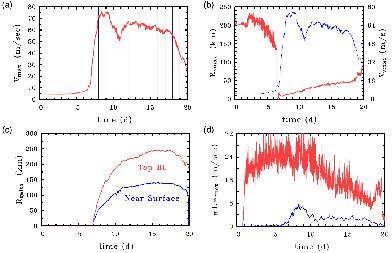当前位置:
X-MOL 学术
›
Q. J. R. Meteorol. Soc.
›
论文详情
Our official English website, www.x-mol.net, welcomes your
feedback! (Note: you will need to create a separate account there.)
Tropical cyclone life cycle in a three-dimensional numerical simulation
Quarterly Journal of the Royal Meteorological Society ( IF 3.0 ) Pub Date : 2021-07-19 , DOI: 10.1002/qj.4133 Roger K. Smith 1 , Gerard Kilroy 1 , M. T. Montgomery 2
Quarterly Journal of the Royal Meteorological Society ( IF 3.0 ) Pub Date : 2021-07-19 , DOI: 10.1002/qj.4133 Roger K. Smith 1 , Gerard Kilroy 1 , M. T. Montgomery 2
Affiliation

|
An idealized, three-dimensional, numerical simulation of tropical cyclone evolution in a quiescent environment on an f-plane is used to explore aspects of the cyclone's life cycle in the context of the rotating-convection paradigm. In the 20-day simulation, the vortex undergoes a life cycle including a gestation period culminating in genesis, a rapid intensification phase, a mature phase, a transient decay and re-intensification phase, a second mature phase and a rapid decay phase. During much of the life cycle, the flow evolution is highly asymmetric, although important aspects of it can be understood within an azimuthally averaged framework, central to which are a boundary-layer control mechanism and a new ventilation diagnostic. The boundary-layer control mechanism provides an explanation for the gradual expansion of the inner core of the vortex. The ventilation diagnostic characterizes the ability of deep convection within a given radius to evacuate the mass of air ascending out of the boundary layer within that radius. The transient decay and re-intensification phase is not associated with an eyewall replacement cycle, but rather with a hitherto undescribed process in which the eyewall becomes fragmented as a rainband complex forms beyond it. This process is interpreted as an interplay between the boundary layer and ventilation. The final rapid decay of the vortex results from the ever increasing difficulty of deep convection to ventilate the air exiting the boundary layer. Any unventilated air flows radially outwards in the lower troposphere and leads to spin-down because of the approximate conservation of mean absolute angular momentum. If found in real cyclones, such transience or final decay might be erroneously attributed to ambient vertical wind shear. The results support the hypothesis that, even in a quiescent environment, isolated tropical cyclone vortices are intrinsically transient and never reach a globally steady state.
中文翻译:

三维数值模拟中的热带气旋生命周期
f静止环境中热带气旋演变的理想化三维数值模拟-plane 用于在旋转对流范式的背景下探索旋风生命周期的各个方面。在为期 20 天的模拟中,涡流经历了一个生命周期,包括在发生时达到顶峰的孕育期、快速强化阶段、成熟阶段、瞬态衰减和再强化阶段、第二成熟阶段和快速衰减阶段。在生命周期的大部分时间里,流动演变是高度不对称的,尽管它的重要方面可以在方位平均框架内理解,其核心是边界层控制机制和新的通风诊断。边界层控制机制为涡旋内核的逐渐膨胀提供了解释。通风诊断表征给定半径内的深对流疏散从该半径内的边界层上升的大量空气的能力。瞬态衰减和重新强化阶段与眼墙更换周期无关,而是与迄今为止未描述的过程有关,在该过程中,眼墙变得支离破碎,形成雨带复合体。这个过程被解释为边界层和通风之间的相互作用。涡旋最终的快速衰减是由于深层对流使离开边界层的空气变得越来越困难。由于平均绝对角动量近似守恒,任何不通风的空气在对流层低层径向向外流动并导致自旋下降。如果在真正的气旋中发现,这种瞬态或最终衰减可能被错误地归因于环境垂直风切变。结果支持这样的假设,即即使在静止环境中,孤立的热带气旋涡旋本质上也是瞬态的,永远不会达到全球稳定状态。
更新日期:2021-09-06
中文翻译:

三维数值模拟中的热带气旋生命周期
f静止环境中热带气旋演变的理想化三维数值模拟-plane 用于在旋转对流范式的背景下探索旋风生命周期的各个方面。在为期 20 天的模拟中,涡流经历了一个生命周期,包括在发生时达到顶峰的孕育期、快速强化阶段、成熟阶段、瞬态衰减和再强化阶段、第二成熟阶段和快速衰减阶段。在生命周期的大部分时间里,流动演变是高度不对称的,尽管它的重要方面可以在方位平均框架内理解,其核心是边界层控制机制和新的通风诊断。边界层控制机制为涡旋内核的逐渐膨胀提供了解释。通风诊断表征给定半径内的深对流疏散从该半径内的边界层上升的大量空气的能力。瞬态衰减和重新强化阶段与眼墙更换周期无关,而是与迄今为止未描述的过程有关,在该过程中,眼墙变得支离破碎,形成雨带复合体。这个过程被解释为边界层和通风之间的相互作用。涡旋最终的快速衰减是由于深层对流使离开边界层的空气变得越来越困难。由于平均绝对角动量近似守恒,任何不通风的空气在对流层低层径向向外流动并导致自旋下降。如果在真正的气旋中发现,这种瞬态或最终衰减可能被错误地归因于环境垂直风切变。结果支持这样的假设,即即使在静止环境中,孤立的热带气旋涡旋本质上也是瞬态的,永远不会达到全球稳定状态。











































 京公网安备 11010802027423号
京公网安备 11010802027423号